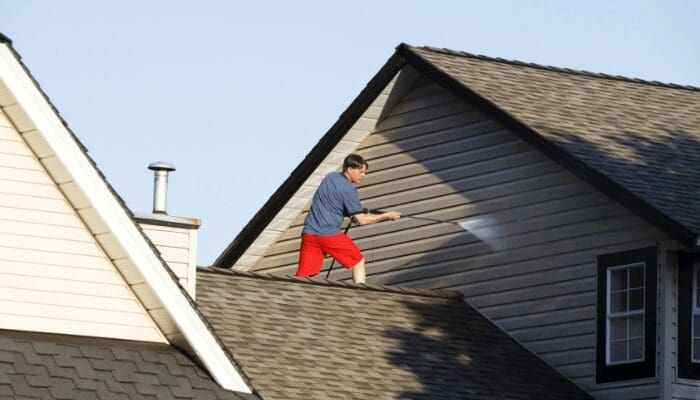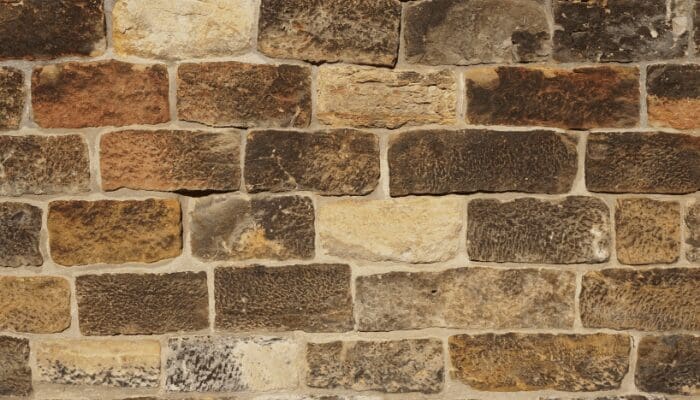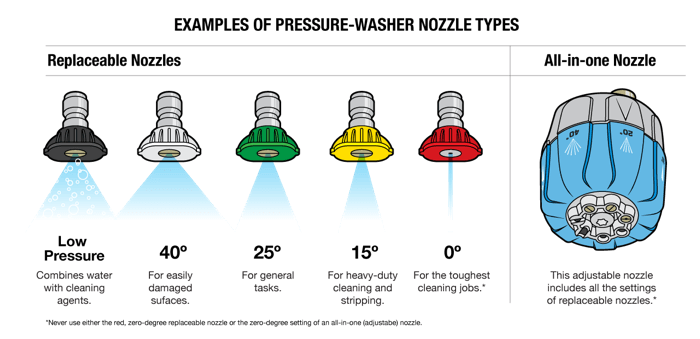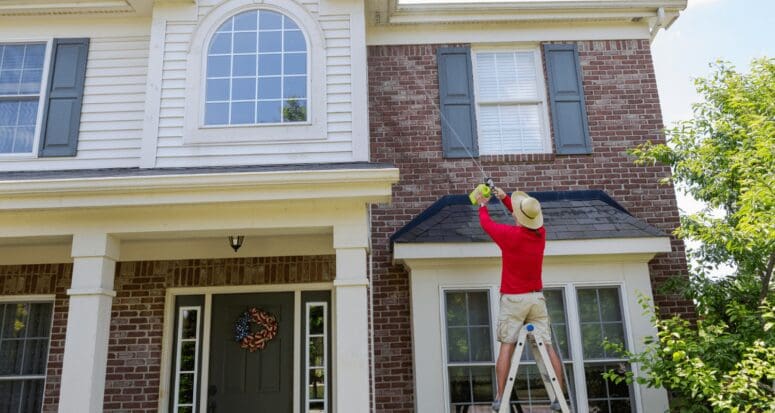How to Clean the Outside of Your House Without Breaking Your Back (or Bank Account)
- Published on
- 2 min read
-
 Christine Bartsch Contributing AuthorClose
Christine Bartsch Contributing AuthorClose Christine Bartsch Contributing Author
Christine Bartsch Contributing AuthorFormer art and design instructor Christine Bartsch holds an MFA in creative writing from Spalding University. Launching her writing career in 2007, Christine has crafted interior design content for companies including USA Today and Houzz.
If you’re a savvy homeowner hoping to make good money on your home sale, you know that improving your home’s curb appeal will get you one step closer to your goal.
You’re likely ahead of the game when it comes to planting fresh flowers, tidying up the landscaping, and making necessary repairs, but do you know the one thing that’s often overlooked? Actually cleaning the outside of your house.
Time and weather are colluding to wreak havoc on your windows, siding, roof, and porches. You might not have noticed, but buyers certainly will. Luckily, thorough cleaning to remove built-up grime and debris can get your home looking brand new again.
So, how do you go about cleaning the exterior of your house? It’s all about taking a smart and safe approach so you don’t do any harm to the property (or yourself!)

To Pressure Wash, Or Not to Pressure Wash
Hosing down your home’s exterior with a pressure washer to make it look brand new again may seem like a no-brainer, but the reality isn’t so cut and dried.
No matter what material your house is made of, if the pressure on that high-powered stream of water is set too high, it’ll do major damage. It can shred wood, crumble brick, gash stucco, shatter stone and even dent aluminum siding. Commercial pressure washers are so powerful, construction workers even use them to chip away solid concrete.


Aside from cosmetic damage, pressure washing can lead to structural issues, too. If your home has any exterior problems, like wood rot or crumbling stucco, pressure washing will just make a bad situation worse. You also run the risk of forcing water into your walls, which can lead to mold or water damage down the line.
So, does that mean you’re stuck scrubbing your whole house with a rag and a bucket? Absolutely not. Done correctly—with the proper safety measures—power washing is a viable option for cleaning the outside of your home.
It comes down to making sure you get the right nozzle and use the proper pounds of pressure for your home.
Pressure washer nozzles vary by angle and stream intensity. The wider the angle of the spray, the less damage it will do. Consumer Reports recommends a 40° angle or a low-pressure nozzle for easily-damaged surfaces like wood or stucco. Experts also advise keeping the nozzle at least six inches away from the surface.

If you don’t want to risk pressure washing the house on your own, you can hire a professional to do the job for you. Fixr estimates that the national average cost to pressure wash a 1,200 square foot house is around $360.
With some shrewd negotiating, you may just be able to get your professional pressure washer to power clean your walkways, porches and decks, too.
“If the driveway is stained or the decks in the backyard, pressure washing is not that expensive and it’ll give it a really fresh look,” says Carol Wolfe, who ranks in the top 1% of real estate agents in Los Angeles.
Top Tips to Make Patios, Porches and Decks Squeaky Clean
Concrete patios, painted porches, stained wood decks—the materials used to build your outdoor living spaces play a big role in how you clean them. On the right pressure setting and with the appropriate nozzle, power washers can safely remove the dirt and moss on all of these surfaces.
Experts advise using a setting of around 1,500 PSI (pounds-per-square-inch) or less for soft wood and porous pavers and stained concrete, or between 2,000 to 3,000 PSI on harder surfaces. For nozzles, Consumer Reports recommends using those with a 25° or 40° angle—especially for wood decks and porches. Test your PSI and nozzle choices on an inconspicuous spot first, to ensure your settings won’t cause any damage.
If moss is a problem on your wood deck or porch, simply spraying it off isn’t enough. Moss grows fast in damp climates, which means it’ll probably grow back before you sell your home unless you treat your wood with a solution that contains chemicals such as powdered oxygen bleach to prevent it. But don’t make the mistake of substituting traditional liquid bleach, which won’t prevent moss regrowth and may damage your lawn.
Stone, brick and concrete patios may be treated as well to prevent moss, mold and mildew from growing back. In fact, you may be able to skip power washing altogether and simply apply a plant-safe cleaning solution to clean your pavers.
Of course, sometimes brick, stone and concrete patios have stains that aren’t so easily removed. If you’re dealing with oil, DIY remedies like a clay-based cat litter or a baking powder solution might do the trick.
For tougher blemishes, such as rust or fertilizer stains, use specially-formulated stain removers that won’t damage your concrete or pavers. Other non-hydrochloric acid-based cleaners are designed to treat efflorescence (those white watermark-like stains).
If your stonework resists all of your cleaning efforts, you may need to use muriatic acid as a last resort.
Muriatic acid, and cleaners that contain it, are effective but dangerous—to your stonework, your plants and you. If you are considering this option, you need to take safety precautions (gloves, goggles, covering greenery), or play it even safer by hiring a professional.
A licensed handyman should be able to handle the task, at a job cost averaging between $100 to $300. Just make sure to ask ahead of time if your handyman has experience cleaning exterior surfaces with muriatic acid.
Window Washers and Screen Savers
Potential buyers who spy window grime while checking out your views will wonder how well you’ve kept up your home. But polishing your windows to a high shine on the inside won’t do you much good if the exterior is covered in raindrop watermarks and other debris.
If you’re already using a pressure washer on your siding and decks, you might want to get your money’s worth by pressure washing your windows as well.
But not so fast.
Unlike decks and siding where you can test out the pressure settings in an inconspicuous place, with windows, you’ll shatter the glass if your setting is too high. Even if the glass stays intact, you risk knocking loose the sealant that keeps your window in and the weather out.
It’s these reasons why power washing professionals won’t do windows with their equipment.
While using a pressure washer against windows is risky, it can be done—if you start on the lowest possible pressure setting and use the right nozzle. Your best bet is a low-pressure nozzle that’s designed to infuse the spray with a cleaning agent that you may need to remove stubborn stains.
A safer alternative to a power washer is an exterior window cleaner packaged to attach to your garden hose. The bottle is designed to mimic the function of the pressure washer with the lower force of your home’s water pressure.
Whether you pressure wash or hose down your windows, the one thing you don’t want to do is let them air dry—or you’ll be left with unsightly streaks.
Instead, purchase an adjustable, long-reach squeegee to pull the moisture off while it’s still wet. Still getting streaks? The pros know that drying the squeegee off on a towel after every single pull will eliminate this.
Of course, you can’t squeegee if you’ve got window screens in the way. Dirty, rusted screens can ruin the view even if your windows are spotless, so give them a thorough cleaning as well.
After wiping them down with a rag to remove any loose debris, simply hit them with the power washer or hose attachments on the same low settings you used on the windows. Any higher than that and your screens may bend, stretch or come apart.
For rust-stained screens, you may be able to save rather than replace them. Scrub them down with a common DIY cleaning solution such as ammonia, dish detergent and water. For stubborn stains, mix up a baking soda paste and let it set for several hours.
Raise the Roof’s Curb Appeal with a Good Cleaning
Many homeowners never think about their roof unless it’s leaking, but when it’s time to sell, it needs to be spruced up just like the rest of your home.
While pressure washers may work to help clean siding, decks, and porches, your roof is one place where they don’t belong. According to the experts, you should never pressure wash a roof because even low-pressure settings may loosen or damage shingles.
So, how exactly do you clean a roof? If yours is free from stains, all it may need is a simple sweeping. If your shingles are secure, you can even use a leaf blower to remove debris from the roof and your gutters, too.

If your roof is covered in moss or has black streaks from algae growth, simply cleaning it off with water won’t do the trick. Chances are the stains will return before your home is sold. For a longer-lasting solution, clean and treat your roof with a product designed to break it down and prevent regrowth.
The Case For Cleaning the Outside of Your House
With so much to do inside your home to get it ready to sell, it’s tempting to leave cleaning the outside of your house off of your to-do list. But if you take the time to give it a thorough scrubbing, the boost in curb appeal may be just the ticket to getting your best offer.
Article Image Source: (Ozgur Coskun/ Shutterstock)
